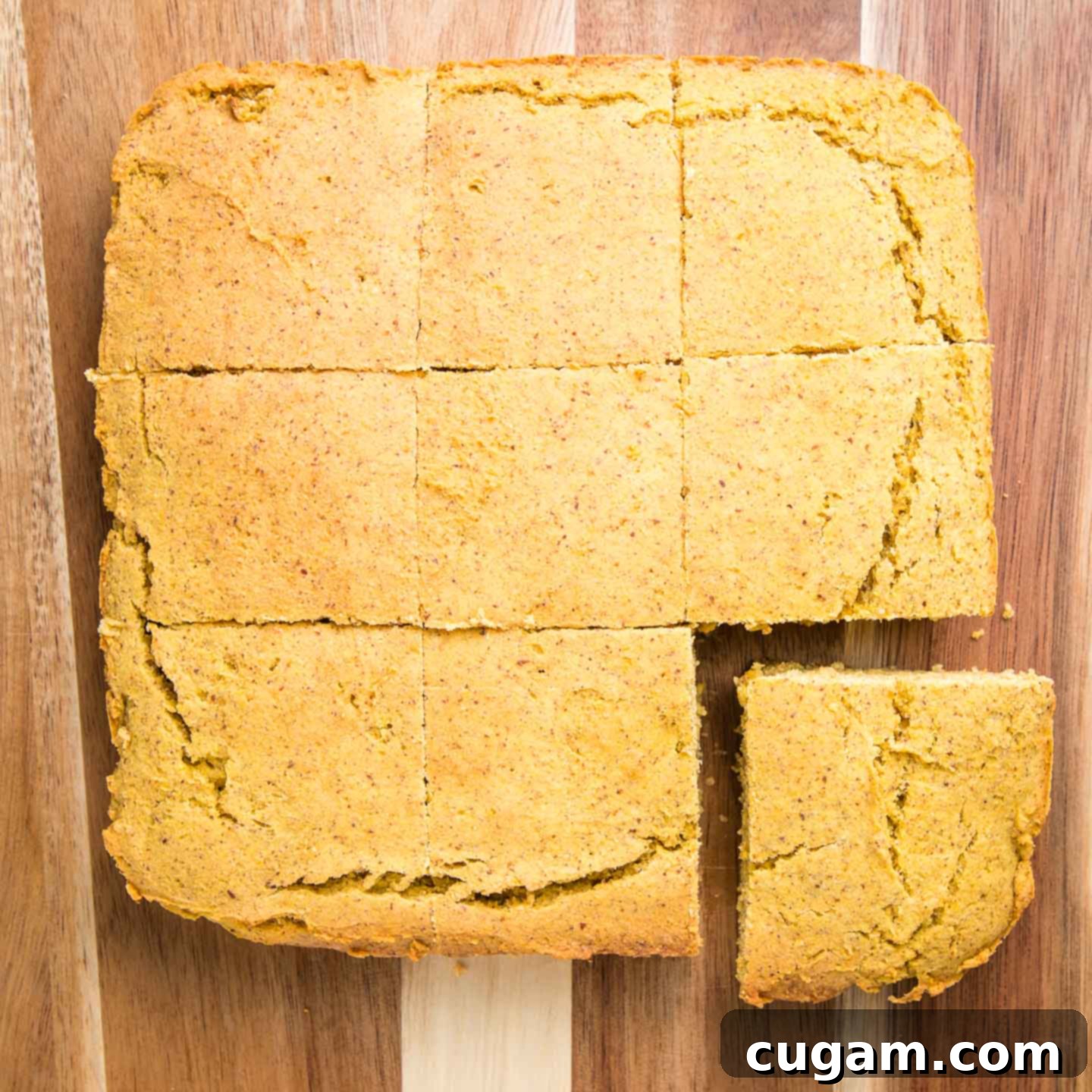Simply the Best Gluten-Free Vegan Cornbread: Perfectly Moist & Flavorful with Puréed Corn Kernels
Prepare to rediscover the joy of cornbread with this incredibly moist and flavorful oven-baked Gluten-Free Vegan Cornbread. What’s the secret to its remarkable texture and ability to hold together without eggs or dairy? It’s all thanks to the clever use of puréed corn kernels! This innovative approach not only ensures a delightfully moist crumb but also amplifies that authentic, sweet corn flavor we all crave. Forget complicated baking – simply blend a few ingredients, mix them in a bowl, and pop it into the oven. In no time, you’ll be enjoying warm, delicious dairy-free and egg-free cornbread that tastes just like the classic, but better for you!
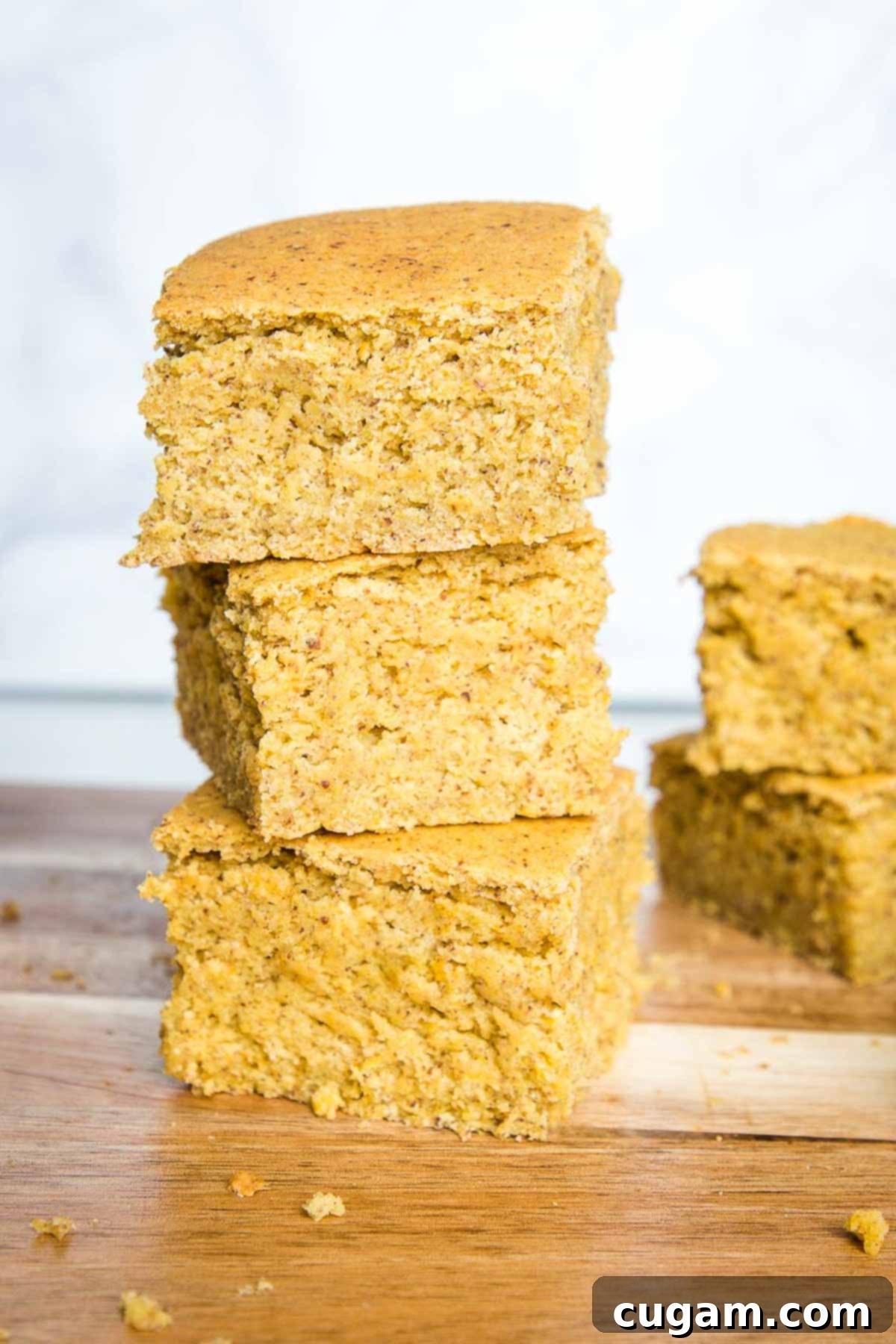
This isn’t just any cornbread; it’s the traditional comfort food you grew up loving, but with a modern, healthy twist. We’ve enhanced its natural goodness to deliver a perfectly moist texture and an irresistible taste that rivals even your Grandma’s cherished recipe. But with one crucial difference: this rendition is an eggless, dairy-free, and refined sugar-free cornbread! It’s a testament to how simple, wholesome ingredients can come together to create something truly exceptional, without compromising on flavor or texture.
This versatile cornbread is an ideal companion for a variety of meals. I often serve it as an easy vegan side dish to complement a hearty bowl of meatless chili or a comforting hearty lentil soup. Beyond everyday meals, it transforms into an essential component for Gluten-free Cornbread Stuffing for Thanksgiving, adding a delightful texture and rich flavor to your holiday feast. It also makes a fantastic and fun addition to game day buffets or potlucks, perfect for sharing with friends and family. Its tender crumb and slightly sweet notes make it a welcome addition to any gathering.
Why You’ll Love This Gluten-Free Vegan Cornbread
This recipe isn’t just about dietary restrictions; it’s about crafting a truly superior cornbread experience. Here’s why this particular recipe stands out:
- Unbeatable Moisture from Puréed Corn: The star of this recipe is undoubtedly the puréed corn kernels. This ingenious addition replaces traditional eggs and much of the butter, providing incredible moisture and a tender crumb without relying on animal products. It’s the “secret ingredient” that ensures your cornbread is never dry or crumbly.
- Perfect Texture, Every Time: We’ve carefully balanced cornmeal and flour to achieve that classic cornbread texture – hearty yet light, with a satisfying bite that isn’t too dense. The blend prevents the cornbread from becoming overly gritty or falling apart.
- Naturally Sweetened & Wholesome: Enjoy the sweet taste of cornbread without any refined sugars. Maple syrup or honey provides a gentle, natural sweetness that complements the corn beautifully, making this a healthier treat you can feel good about.
- Dietary Inclusive: Gluten-Free & Vegan: Whether you’re navigating allergies, dietary preferences, or simply looking for healthier alternatives, this recipe ticks all the boxes. It’s completely gluten-free, dairy-free, and egg-free, making it accessible for many to enjoy.
- Surprisingly Easy to Make: Despite its impressive results, this cornbread is incredibly simple to prepare. With minimal hands-on time and the help of a blender or food processor, you’ll have a batch of homemade cornbread ready in under an hour.
Essential Ingredients and Thoughtful Substitutions
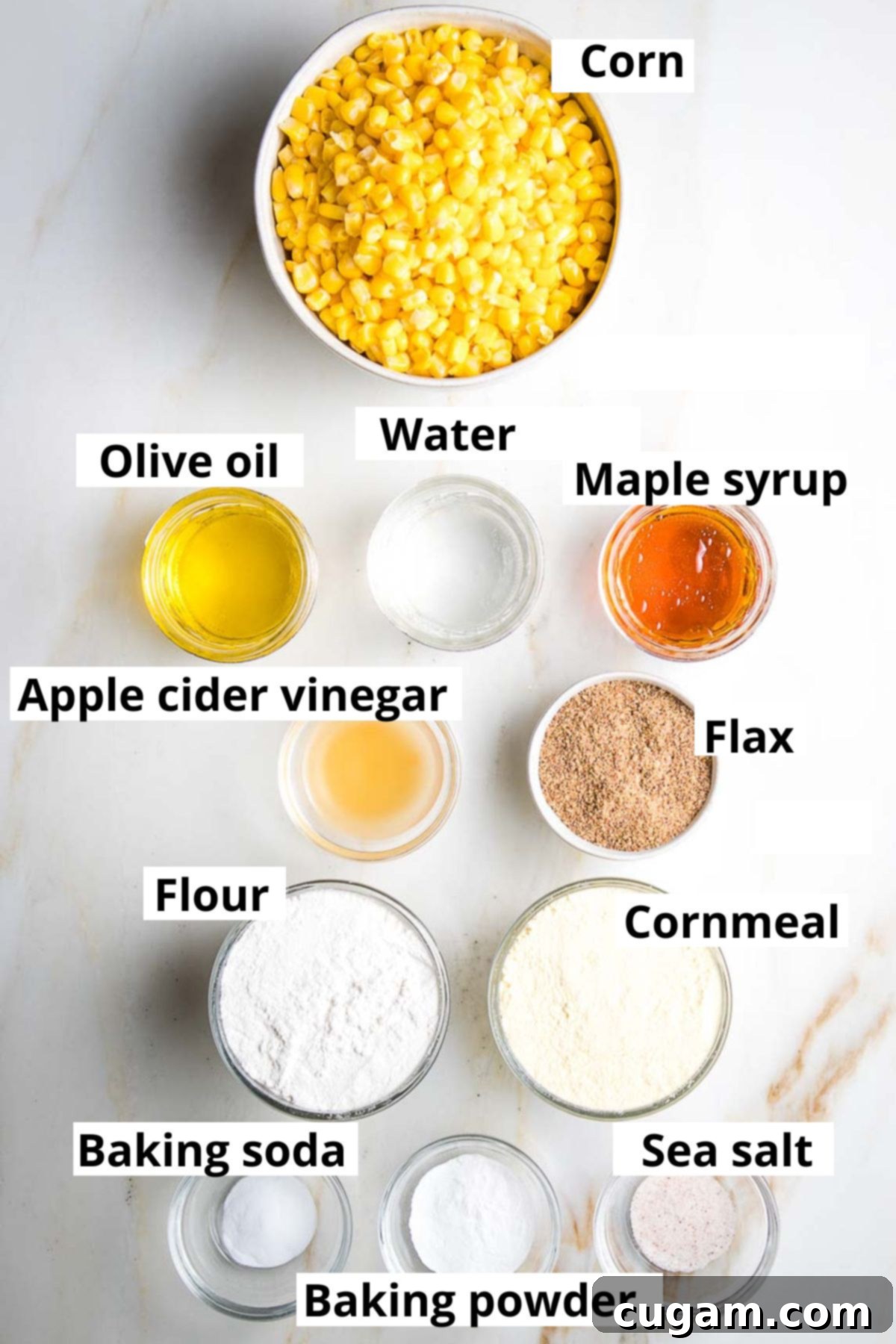
Crafting the perfect cornbread starts with understanding each ingredient and its role. Here’s a deeper dive into what you’ll need and how to make thoughtful adjustments:
- Corn: Yes, corn in cornbread! It’s not just for flavor; in this recipe, it’s also a key ingredient for moisture. Always opt for frozen corn, thawed, for the best results. Frozen corn retains more of its natural moisture and sweetness compared to canned varieties, which can often be too watery or alter the taste. Avoid canned corn if possible, as it may introduce unwanted textures or flavors.
- Cornmeal: This is the foundation of cornbread. For a more authentic, hearty texture, I recommend using stone-ground cornmeal. It offers a slightly coarser feel that many associate with traditional cornbread. However, if fine-ground cornmeal is all you have on hand, it will work perfectly fine, yielding a slightly smoother crumb. Just ensure it’s fresh for optimal flavor.
- Flour: To keep this recipe truly gluten-free, selecting the right all-purpose flour blend is crucial. I achieved excellent results with King Arthur Gluten-free measure for measure flour, which is designed for easy substitutions in traditional recipes. This blend consistently delivers a perfect gluten-free vegan cornbread texture and taste. If you’re not gluten-free, sprouted spelt flour or even whole wheat flour can also be used, though the texture might vary slightly. Always use a flour you know you tolerate well.
- Ground Flaxseed (Flaxmeal): This incredible ingredient acts as a powerful binder in vegan baking, helping our eggless cornbread hold together beautifully. When combined with liquid, ground flax forms a gel-like consistency that mimics the binding properties of eggs. If you don’t have ground flax, you can substitute with ground chia seeds. The key is to ensure they are ground, as whole seeds won’t create the necessary binding effect. Make sure to grind them finely before adding to the mixture.
- Maple Syrup: For a touch of natural sweetness without refined sugars, maple syrup is my go-to. Its rich, nuanced flavor complements the corn wonderfully. If you consume honey and prefer its taste, it makes an excellent substitute and can be used in the same quantity. You can also adjust the amount to suit your personal sweetness preference (see notes below).
- Apple Cider Vinegar: This acidic ingredient is more than just a flavor enhancer; it plays a critical role in leavening. When combined with the baking soda and ground flaxseed, apple cider vinegar creates a reaction that helps the cornbread rise, resulting in a light and airy texture. It’s a binder extraordinaire and an essential component for the perfect crumb.
- Olive Oil (or Avocado Oil): A small amount of olive oil contributes to the overall moisture and richness of the cornbread. It helps achieve a tender crumb and a subtly crisp exterior. For an oil-free option, you can increase the water content (see recipe notes), though the texture may be slightly less moist. Avocado oil is another great neutral-tasting alternative if you prefer.
How to Make This Unforgettably Moist Gluten-Free Vegan Cornbread
The secret to achieving the most flavorful and moist cornbread you’ve ever tasted truly lies in the corn itself. Yes, you heard that right! The star ingredient that elevates this recipe is the corn, specifically puréed to perfection. Follow these simple steps for a truly delicious result.
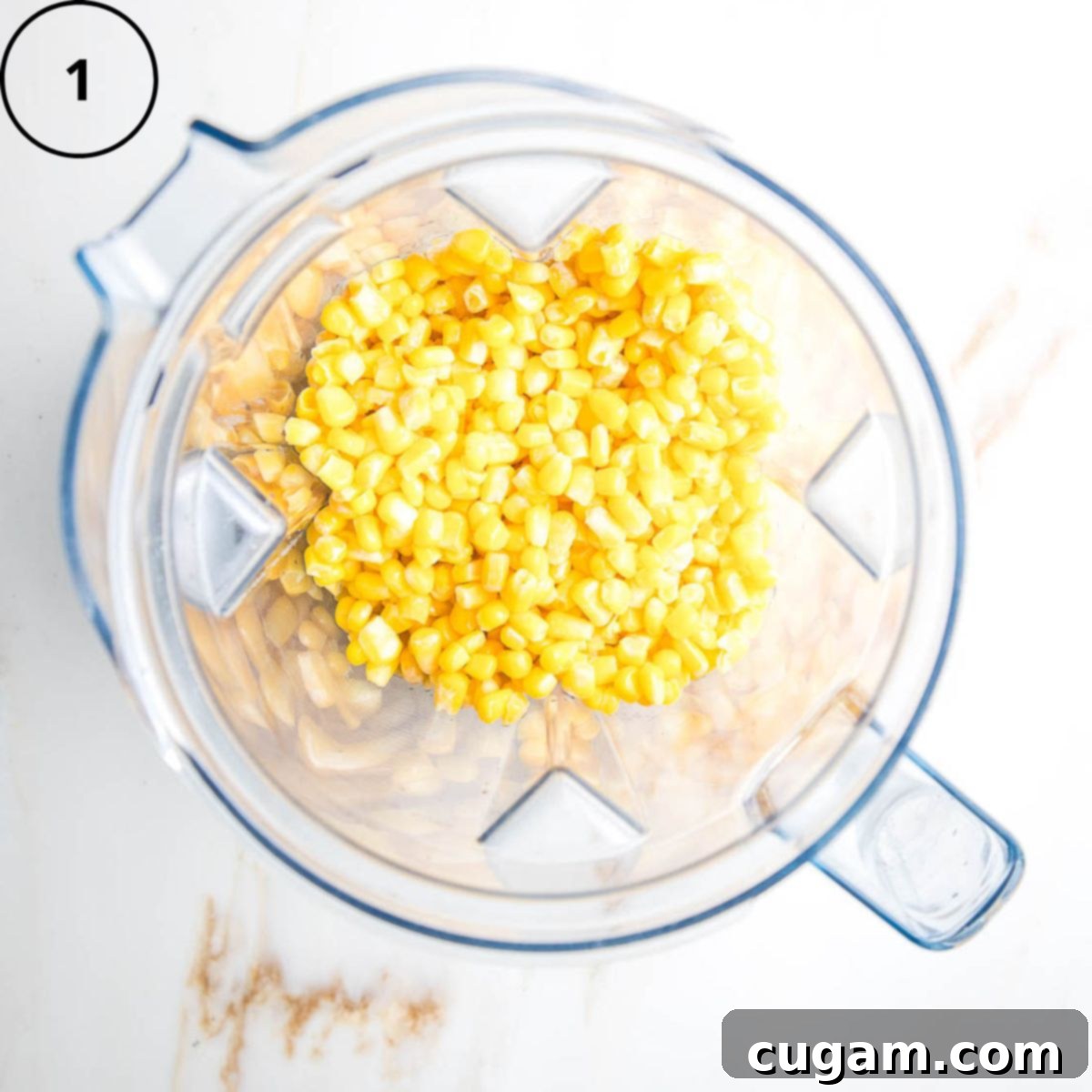
Step 1: The Magic of Puréed Corn. Begin by placing your defrosted frozen corn kernels, along with the specified amount of water and olive oil, into the pitcher of a high-speed blender or the bowl of a food processor. This step is a fantastic hack for achieving perfect texture in vegan cornbread; the blended corn, water, and olive oil create a rich, moist base that eliminates the need for eggs or dairy butter. Refer to the recipe card notes if you prefer to omit the oil.
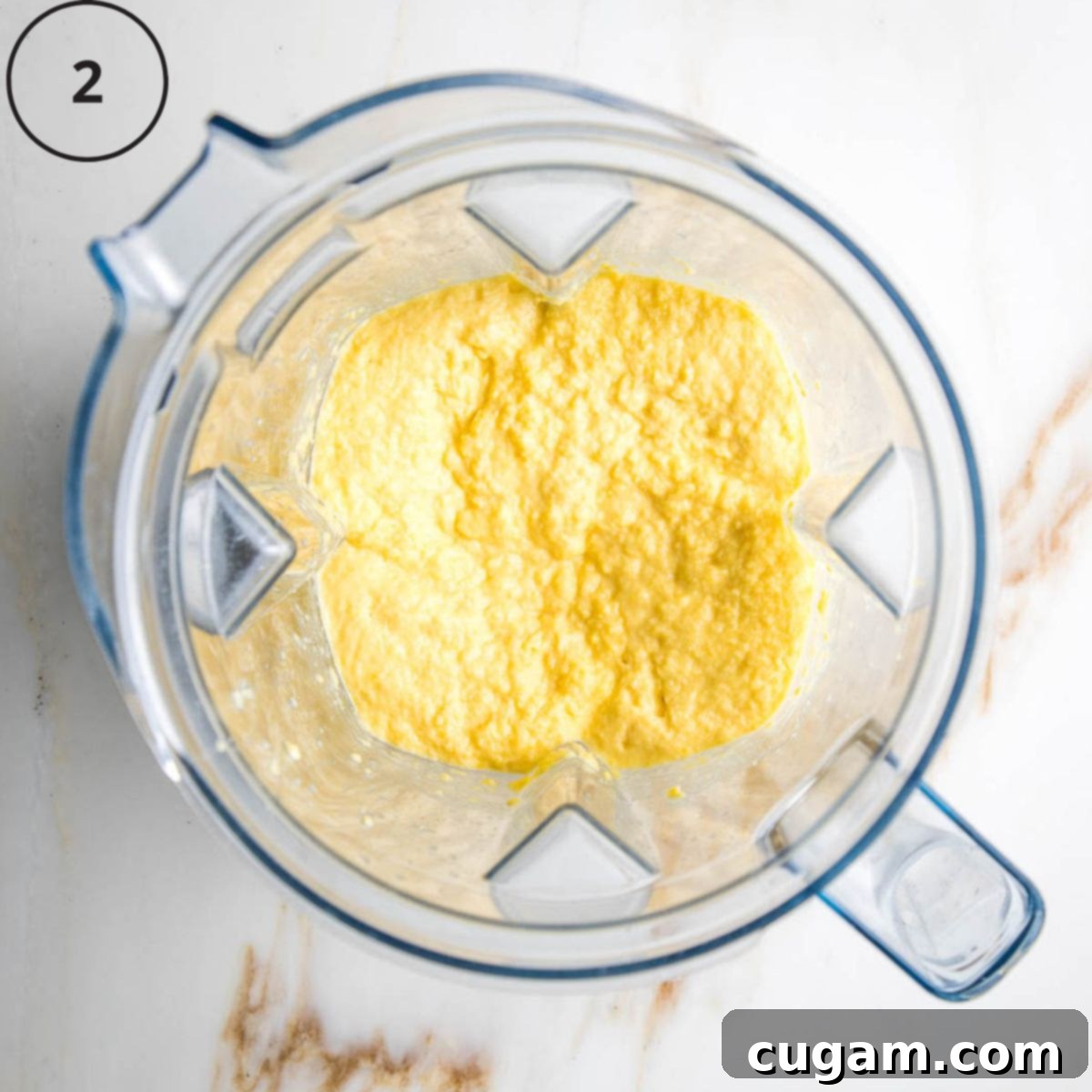
Step 2: Blend to Silky Smoothness. Process the mixture until the corn kernels have completely broken down and you’re left with a super thick, smooth purée. There should be no visible chunks of corn. This is crucial for creating that wonderfully moist texture. Ensure it’s thoroughly blended before moving on to the next additions. The smoother the corn purée, the more uniform and tender your cornbread will be.
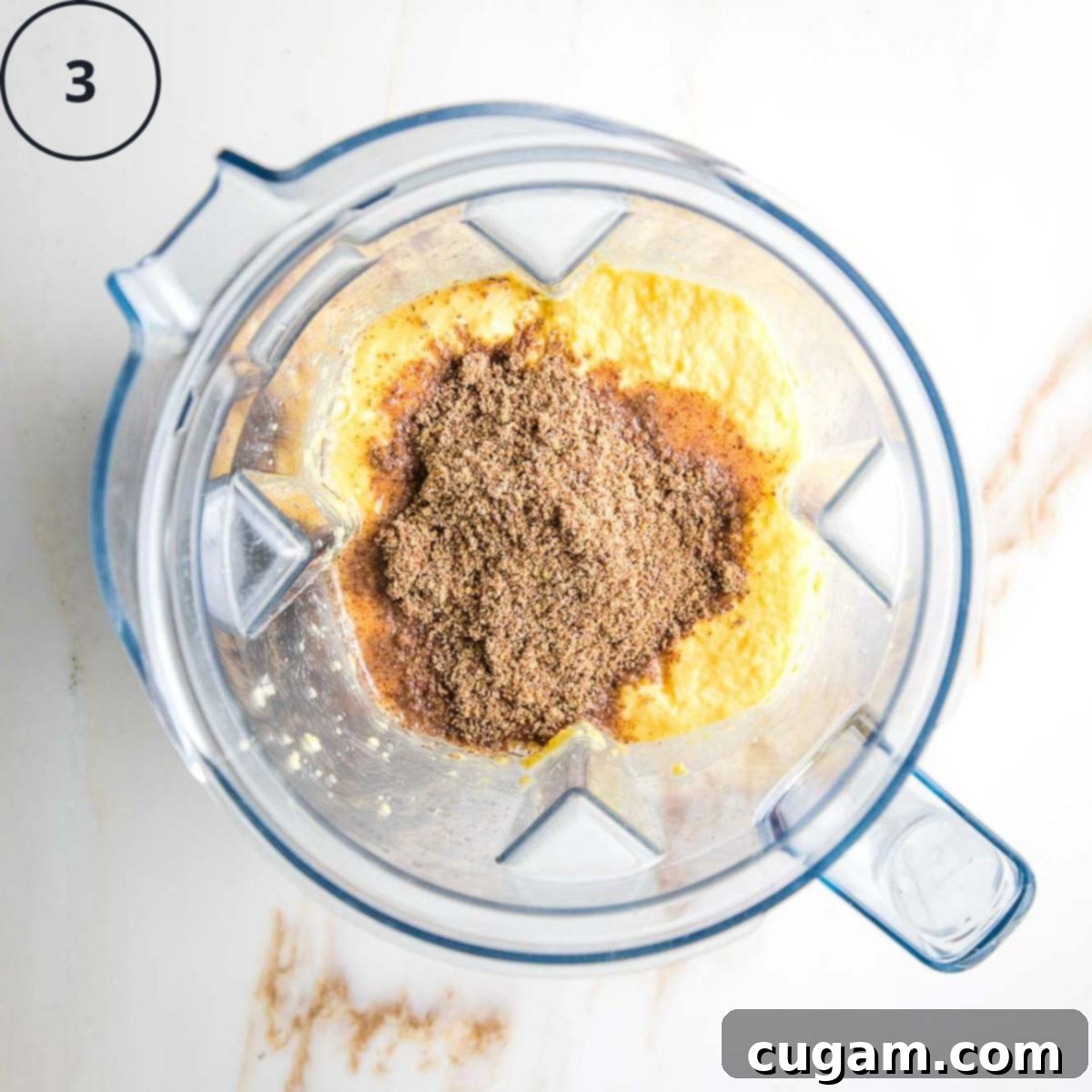
Step 3: Introduce the Binders and Sweetness. Now, add the apple cider vinegar and ground flaxseed to the blender. These ingredients are essential; the apple cider vinegar works with baking soda (added later) for lift, while the ground flax acts as an extraordinary binder, replacing eggs and providing that familiar cornbread texture. For sweetness, I find ¼ cup of maple syrup or honey to be just right, providing a subtly sweet balance without overpowering the corn flavor. If you prefer a sweeter cornbread, feel free to add an additional 1-2 tablespoons of your chosen sweetener.
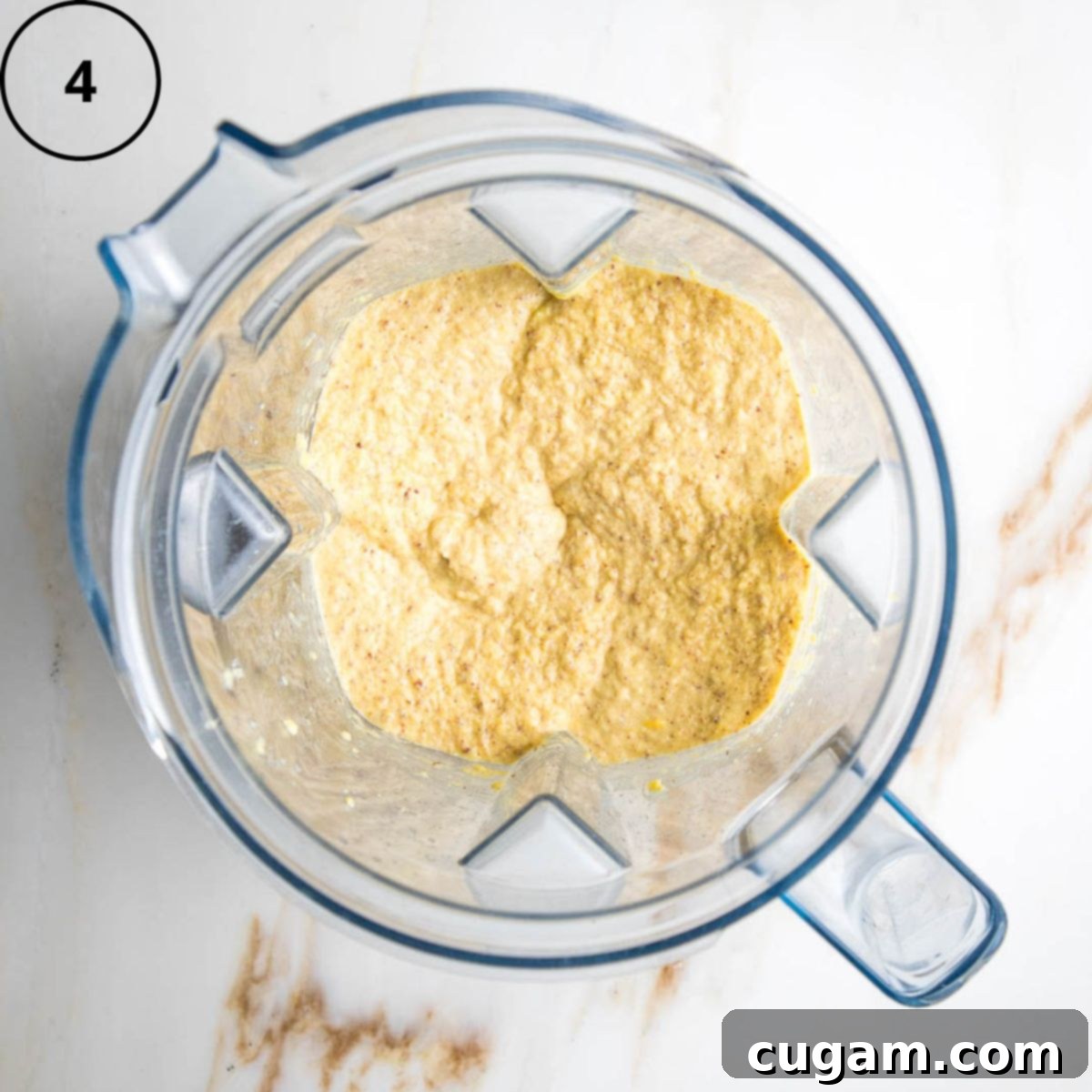
Step 4: The Resting Phase and Prep Work. Blend everything once more until all the wet ingredients are thoroughly incorporated and smooth. Once blended, let this mixture sit for 10 minutes. This resting time is crucial as it allows the ground flaxseed to absorb the liquids and thicken, forming a gel-like “flax egg” that will bind your cornbread. Use this brief waiting period to preheat your oven to the specified temperature (375°F / 190°C), prepare your baking pan, and gather all your dry ingredients, ensuring a smooth transition for the next steps.
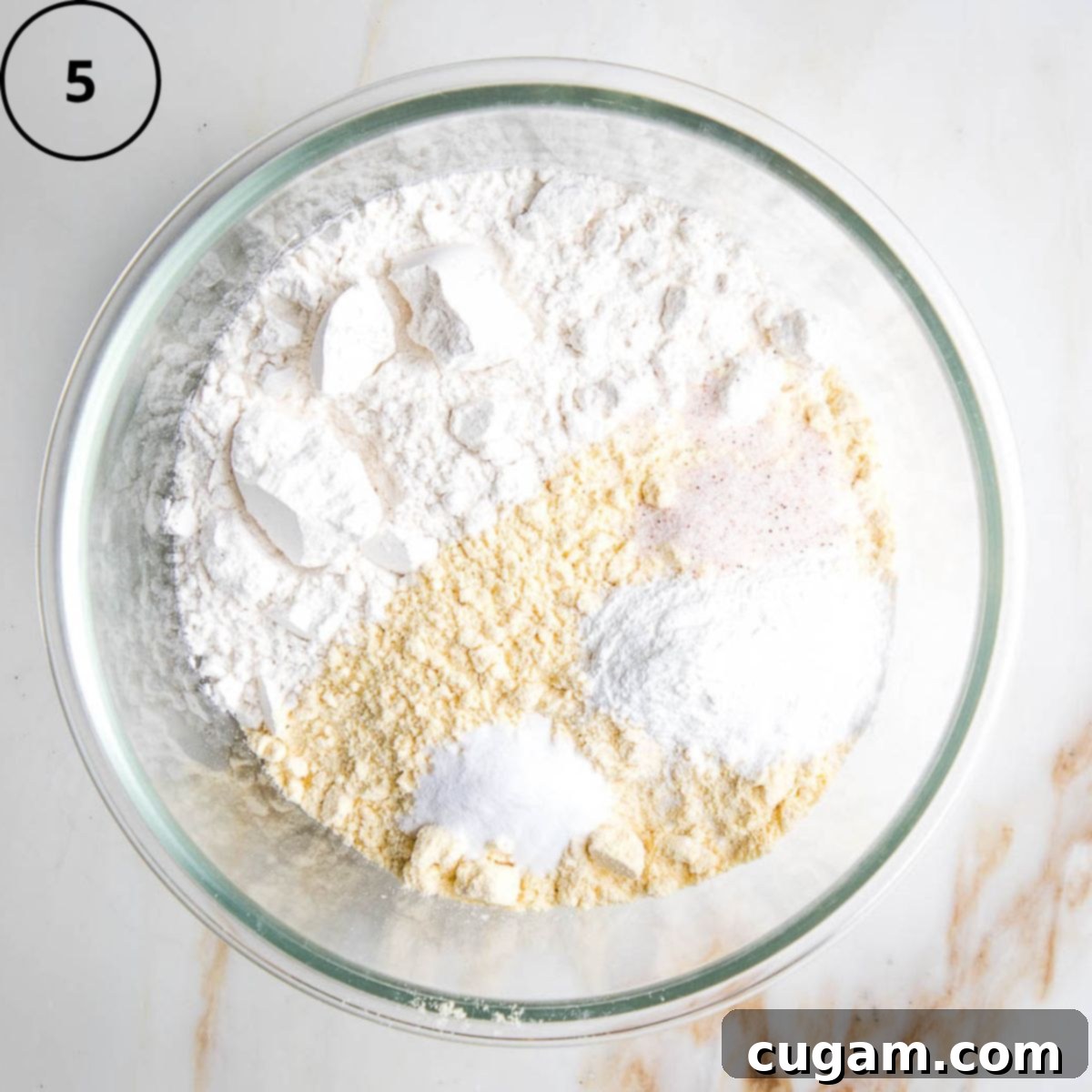
Step 5: Prepare Your Dry Ingredients. While your wet mixture rests, take a large mixing bowl and combine your dry ingredients: gluten-free all-purpose flour, cornmeal, baking powder, baking soda, and salt. Whisk them together thoroughly. This ensures that the leavening agents and salt are evenly distributed throughout the batter, leading to an even rise and consistent flavor in your baked cornbread. Proper mixing of dry ingredients is key to avoiding dense spots or uneven texture.
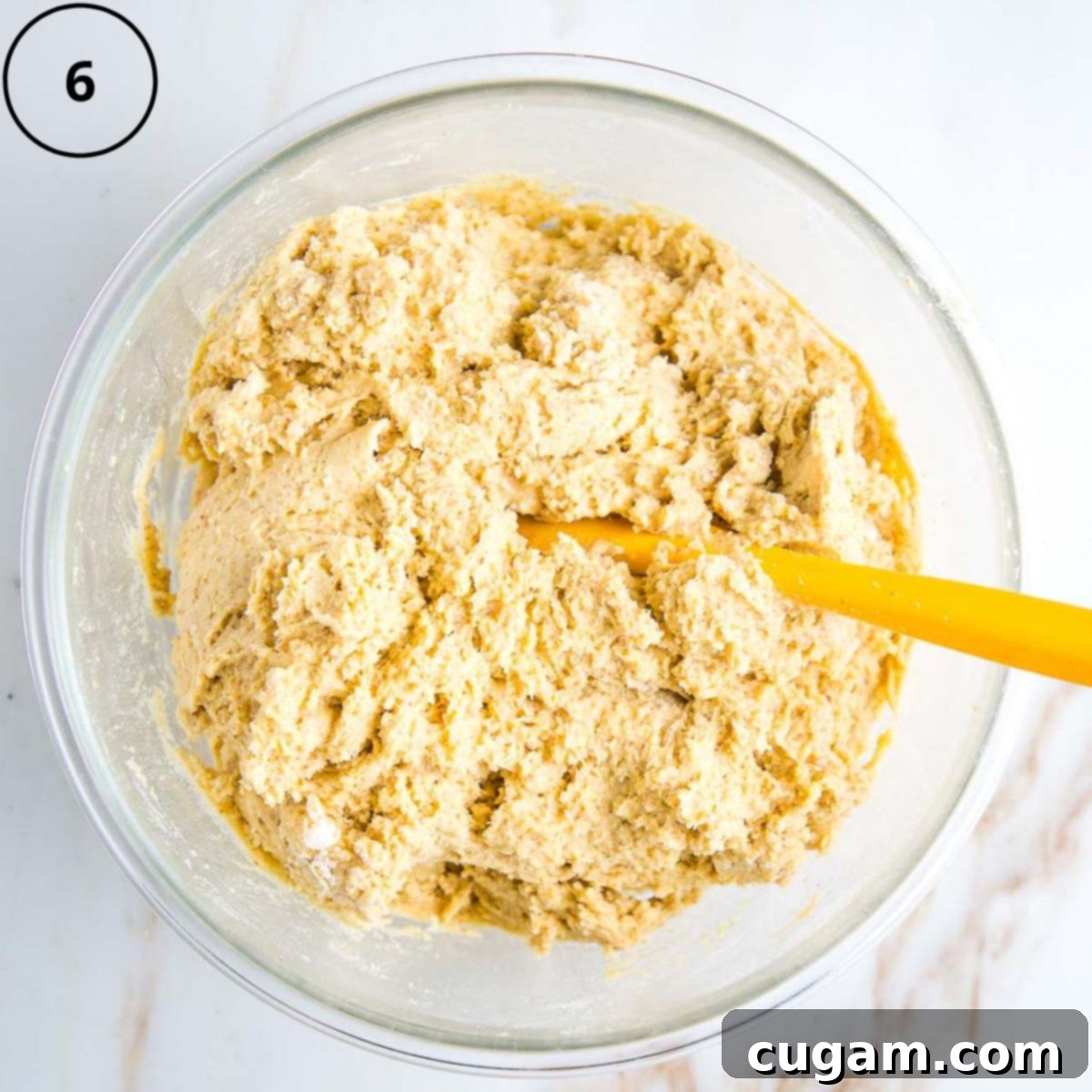
Step 6: Combine Wet and Dry – But Do Not Overmix! Pour your rested corn mixture from the blender into the bowl with the dry ingredients. Mix them together by hand using a spatula or spoon until they are just combined. This is a critical step in cornbread making: overmixing will develop the gluten (even in GF flours, it can affect texture) and result in tough, dry cornbread. Be sure to scrape the bottom of the bowl to incorporate all the dry flour, then stop mixing as soon as no streaks of dry ingredients remain. The batter will be notably thick and pasty; this is exactly the right consistency for a perfectly moist cornbread.
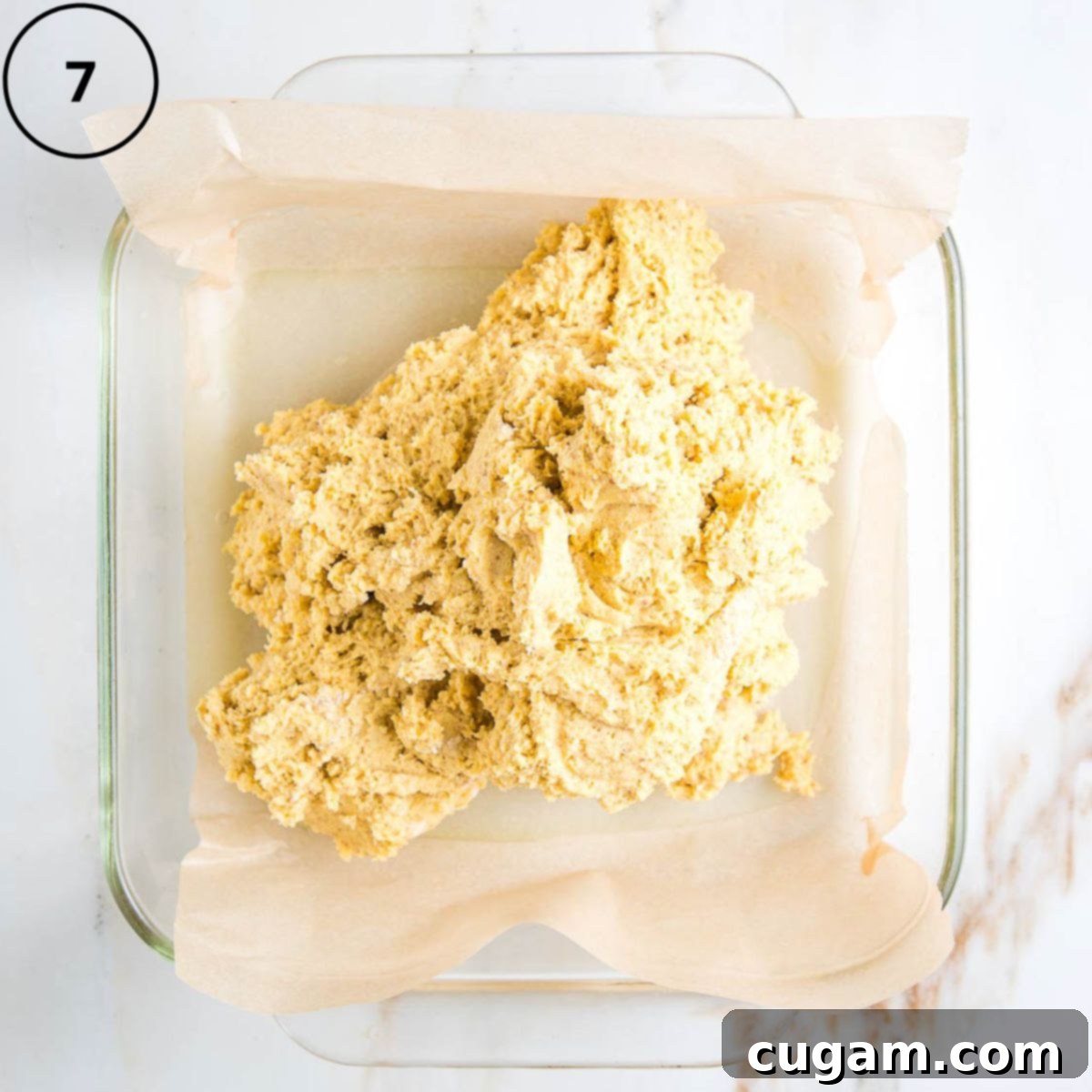
Step 7: Prepare Your Baking Vessel. Carefully transfer the thick batter into your chosen baking pan. For easy removal and cleanup, I recommend using an 8×8-inch square glass baking pan lined with unbleached parchment paper. The parchment paper not only prevents sticking but also makes lifting the finished cornbread out a breeze. Alternatively, for those who love a beautifully crispy edge and rustic appeal, bake in an 8-inch cast iron skillet, ensuring it’s well-greased with olive oil and preheated slightly in the oven for an even crispier crust.
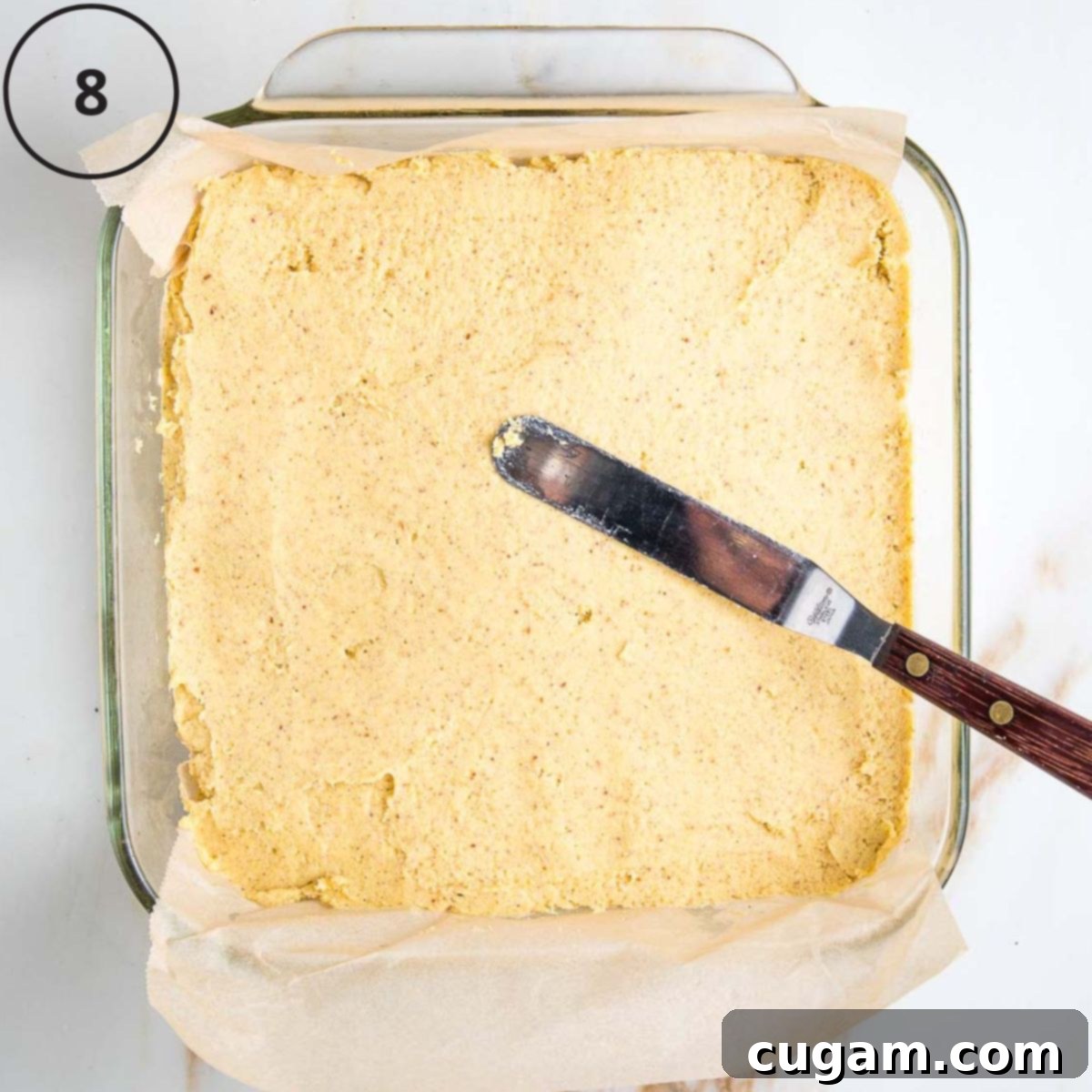
Step 8: Smooth the Batter. Because the batter is thick, it won’t spread on its own. Use an offset spatula or the back of a spoon to gently spread the batter evenly into the prepared pan. This ensures that your cornbread bakes uniformly, leading to a consistent texture and beautiful golden-brown top across the entire surface. A smooth top also helps prevent uneven browning or dry spots.
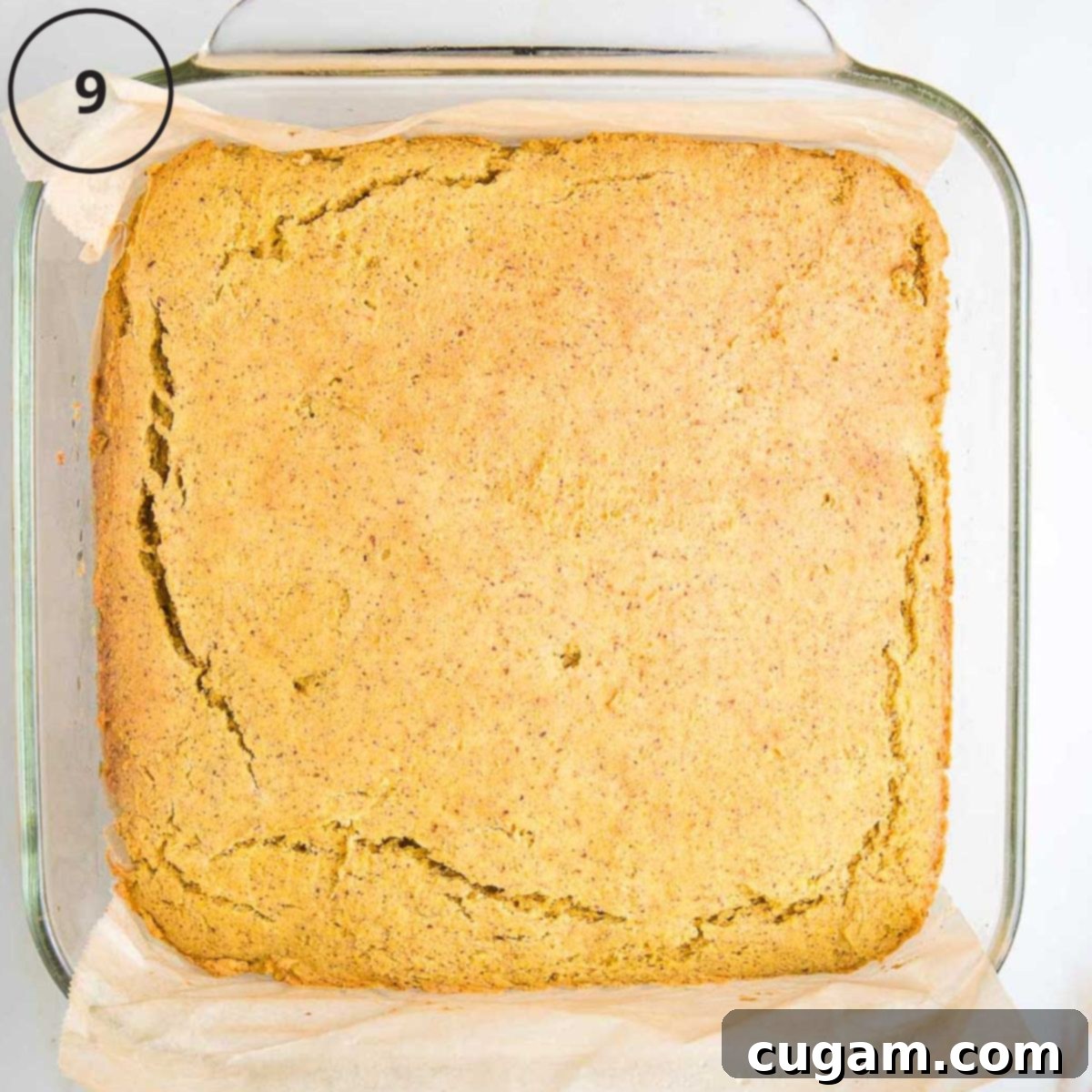
Step 9: Bake to Golden Perfection. Place the pan in your preheated 375°F (190°C) oven and bake for approximately 35 minutes. Baking time can vary slightly depending on your oven, so keep an eye on it. The cornbread is done when a toothpick inserted into the center comes out clean, and the top is a beautiful golden brown with enticing cracks. If it needs a little more time, bake for an additional 3-5 minutes, checking frequently.
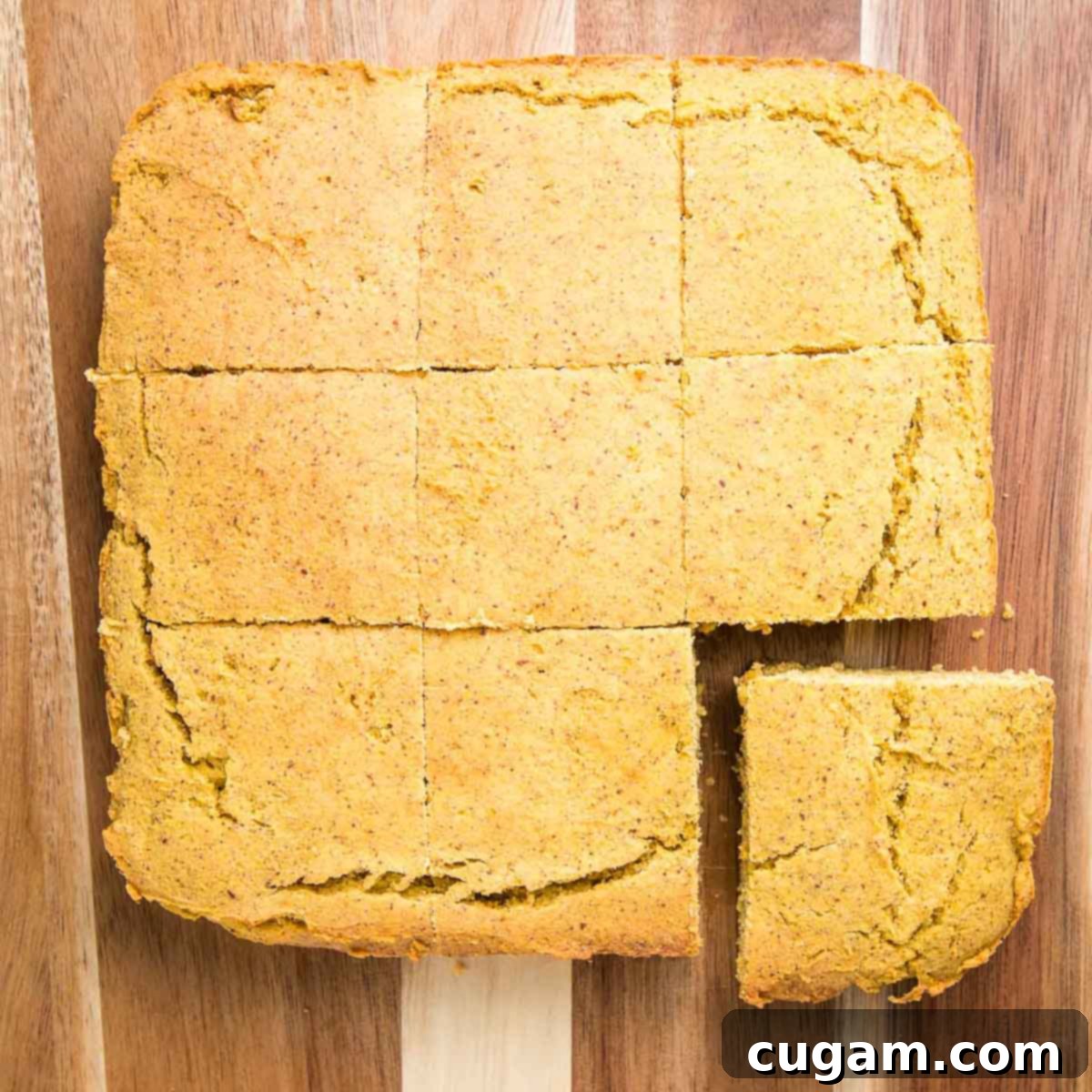
Step 10: Cool, Cut, and Enjoy. Once baked, remove the cornbread from the oven. If you used parchment paper, carefully lift it out of the pan and transfer it to a wire rack to cool. This step is crucial: allow the cornbread to cool completely before attempting to cut it into squares. Cutting it too soon can cause it to crumble, especially with gluten-free recipes. Once cooled, slice into squares and savor. This Gluten-Free Vegan Cornbread stores wonderfully in an airtight container at room temperature for up to 4 days, in the refrigerator for a week, or it can be frozen for up to 3 months, making it perfect for meal prep or quick treats.
Debra’s Pro Tips for Your Best Gluten-Free Vegan Cornbread
- Mindful Mixing is Key: Remember, the golden rule for tender cornbread is to mix the wet and dry ingredients until just incorporated. Over-mixing develops gluten (even in GF flours, it affects texture) and can lead to a dense, tough, or rubbery crumb. As soon as you see no dry streaks, stop!
- The Perfect Cornmeal-to-Flour Ratio: Achieving a moist, tender cornbread means striking the right balance. Too much cornmeal can result in a dry, crumbly texture. This recipe thoughtfully combines cornmeal with all-purpose flour to ensure your cornbread is beautifully moist and holds its shape without being overly dense or gritty.
- Patience is a Virtue (Especially When Cooling): It’s tempting to cut into that warm, fragrant cornbread right out of the oven, but resist the urge! Gluten-free baked goods need time to set and firm up. If you cut the cornbread too soon (before about 15-20 minutes of cooling), it may fall apart or appear crumbly. Give it that extra cooling time on a wire rack, and it will hold together much better, allowing for clean, perfect squares.
- For a Crispier Edge: If you love a delicious, golden-brown crust, bake your cornbread in a cast iron pan. Preheat your cast iron skillet with a tablespoon of olive or avocado oil in the oven as it preheats. Pouring the batter into a hot, greased skillet will give you those coveted crispy edges and a beautifully browned bottom.
- Forgot to Defrost Your Corn? No Problem!: Life happens, and sometimes we forget to plan ahead. If your frozen corn isn’t defrosted, don’t fret! Simply pour the frozen corn into a colander and rinse it under warm (not hot) running water until it reaches room temperature. Pat it dry gently before adding to the blender.
- Adjusting Sweetness: This recipe uses a moderate amount of maple syrup for a balanced flavor. If you prefer your cornbread on the sweeter side, consider adding an extra 1-2 tablespoons of maple syrup or honey to the wet ingredients in step 3.
- Storage for Longevity: Proper storage ensures your cornbread stays fresh. Keep it in an airtight container at room temperature for up to 4 days, in the refrigerator for up to a week, or wrapped tightly and frozen for up to 3 months. Thaw frozen cornbread at room temperature or gently reheat in the oven for a quick treat.
Did you know commenting and rating recipes is one of the best ways to support your favorite food bloggers? If you made this recipe, please consider a five-star rating below and leave a comment. Also, please share your photos on Instagram by tagging me @dkhealthcoach and using the hashtag #debraklein. Your support means the world!
📖 Recipe: Gluten-Free Vegan Cornbread with Puréed Corn Kernels
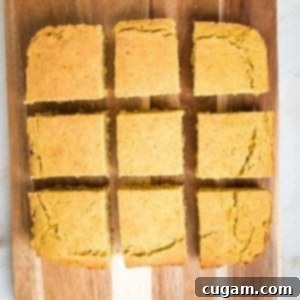
Gluten-Free Vegan Cornbread with Puréed Corn Kernels
Rate this Recipe
Pin Recipe
Equipment
-
Stainless steel mixing bowls
-
Parchment Baking Paper
-
2 Qt Glass Baking Dish with Lid
-
Blender
-
Colander
Ingredients
- 1 16-oz package frozen corn (2 cups), defrosted
- ¼ cup water
- ¼ cup olive oil*
- ¼ cup maple syrup or honey*
- 1 Tablespoon apple cider vinegar
- ⅓ cup ground flax flaxmeal
- 1 cup flour*
- 1 cup cornmeal preferably stone ground
- 2 teaspoons baking powder
- ½ teaspoon baking soda
- ½ teaspoon coarse sea salt
Instructions
-
Prepare the Wet Mixture: In a blender or food processor, combine the defrosted corn, water, and olive oil*. Blend until completely smooth and the corn is fully broken down. Next, add the maple syrup (or honey), apple cider vinegar, and ground flaxseed. Blend again until all ingredients are well incorporated. Let this wet mixture sit for 10 minutes to allow the flaxseed to thicken, forming a natural binder.
-
Preheat Oven & Prepare Pan: While the wet mixture rests, preheat your oven to 375°F (190°C). Prepare your baking pan: either line an 8×8-inch square pan with unbleached parchment paper for easy removal, OR, for a crispier crust, grease an 8-inch cast iron skillet with 1 tablespoon of olive or avocado oil and place it in the oven to preheat alongside the oven.
-
Mix Dry Ingredients: In a separate medium-sized bowl, whisk together the gluten-free flour, cornmeal, baking powder, baking soda, and coarse sea salt until thoroughly combined. This ensures even distribution of the leavening agents.
-
Combine Wet and Dry: Pour the corn-flax mixture from the blender into the bowl with the dry ingredients. Using a spatula or spoon, mix gently until just combined. Be careful not to overmix; stop as soon as there are no visible streaks of dry flour. The batter will be thick and pasty.
-
Bake the Cornbread: Transfer the thick batter into your prepared pan. Use an offset spatula or the back of a spoon to spread it evenly. Bake for 35 minutes, or until a toothpick inserted into the center comes out clean, and the top is golden brown and slightly cracked. Depending on your oven, it might need an additional 3-5 minutes.
-
Cool Before Cutting: If you lined your dish with parchment paper, carefully lift the cornbread out and transfer it to a wire rack. Allow it to cool completely before cutting into squares. This is essential for preventing crumbling and ensuring the cornbread holds its shape.
-
Storage: Store the cooled cornbread in an airtight container at room temperature for up to 5 days, or in the refrigerator for up to a week. For longer storage, freeze it for up to 3 months.
Notes
SWEETNESS: This recipe delivers a moderately sweet cornbread. If you prefer a sweeter version, feel free to add an additional 1-2 tablespoons of maple syrup or honey to the wet ingredients.
FLOUR: In these photos, I used a gluten-free 1-to-1 measure-for-measure flour blend, which yielded excellent results. This recipe also works well with sprouted spelt flour (my personal favorite, though not gluten-free) or cassava flour (another great gluten-free option). For those not needing gluten-free, whole wheat flour can also be used. The key is to use a flour that you typically use for baked goods and know you tolerate well, and that you have on hand.
CORNMEAL: For the best texture and flavor, I recommend purchasing stone-ground, non-GMO cornmeal if available. If you prefer a more pronounced “gritty” texture, opt for coarse ground cornmeal. For a smoother, more tender crumb, fine-ground cornmeal is ideal, which I used for the cornbread shown in the photos.
OIL-FREE OPTION: You can absolutely make this recipe oil-free! Simply omit the olive oil and increase the water in the wet mixture to ½ cup. While the cornbread will be slightly less moist, it will still be delicious and hold its shape. This oil-free version is particularly excellent if you’re making cornbread stuffing or using it for dipping into a savory chili or soup.
Nutrition
Note
The nutrition calculations were done using online tools. To obtain the most accurate representation of the nutritional information in any given recipe, you should calculate the nutritional information with the actual ingredients you used. You are ultimately responsible for ensuring that any nutritional information is accurate, complete and useful.
Frequently Asked Questions (FAQ)
Can I use fresh corn instead of frozen?
Yes, you can! If using fresh corn, you’ll need about 2 cups of kernels. Simply cut the kernels off two medium-sized ears of corn. Fresh corn will offer an even brighter, sweeter corn flavor, making your cornbread exceptionally delicious. Ensure it’s puréed just as you would frozen corn.
Can I make this cornbread entirely oil-free?
Absolutely! For an oil-free version, simply omit the ¼ cup of olive oil from the recipe. To compensate for the loss of liquid and maintain some moisture, increase the water in the wet mixture from ¼ cup to ½ cup. While the texture might be slightly less moist and the crust not as crispy, it will still yield a perfectly delicious and wholesome cornbread, ideal for stuffing or dipping into chili.
What type of gluten-free flour blend works best?
I highly recommend a high-quality “1-to-1” or “measure-for-measure” gluten-free all-purpose flour blend, such as King Arthur’s. These blends are specifically formulated to mimic traditional wheat flour and typically contain xanthan gum, which helps with structure in gluten-free baking. If your blend doesn’t contain xanthan gum, you might consider adding ¼ teaspoon to the dry ingredients for extra binding.
How do I prevent my cornbread from being too crumbly?
Several factors contribute to a non-crumbly cornbread. Firstly, ensure you’re using ground flaxseed (flaxmeal) as specified; its binding properties are crucial. Secondly, avoid over-mixing the batter; stop as soon as the wet and dry ingredients are just combined. Lastly, and perhaps most importantly, allow the cornbread to cool completely on a wire rack before slicing. This allows the internal structure to set properly, preventing it from falling apart when cut.
Can I add mix-ins to this cornbread?
Certainly! This recipe is a fantastic base for various delicious additions. Consider folding in some chopped jalapeños for a spicy kick, a handful of vegan cheese shreds, or even some extra corn kernels (whole, not puréed) for added texture, just before baking. Blueberries also make a wonderful sweet addition for a breakfast treat.
